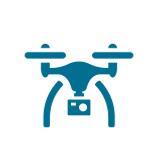Recreational Drone Rules
You must not fly your drone in a way that creates a hazard to another aircraft, person or property, so follow these rules every time you fly:

You must only fly during the day and keep your drone within the visual line of sight. This means being able to see the aircraft with your own eyes (rather than through a device) at all times.

You must not fly your drone higher than 120 metres (400ft) above the ground.

You must keep your drone at least 30 metres away from other people.

You must not fly your RPA over or near an area affecting public safety or where emergency operations are underway(without prior approval). This could include situations such as a car crash, police operations, a fire and associated firefighting efforts, and search and rescue.

You must only fly one RPA at a time.

You must not fly over or above people. This could include beaches, parks, events, or sports ovals where there is a game in progress.



Remember, you must not operate your drone in a way that creates a hazard to another aircraft, person or property.
If your drone weighs more than 100g, you must keep at least 5.5km away from controlled aerodromes. Flying within 5.5km of a non-controlled aerodrome or helicopter landing site (HLS) is possible, but only if no human-crewed aircraft operate to or from the aerodrome. If you become aware of human-crewed aircraft operating to or from the aerodrome/HLS, you must manoeuvre away from the aircraft and land as soon as safely possible.
Respect personal privacy; don’t record or photograph people without their consent—this may breach state laws.
Flying commercially or for economic gain is illegal, unless you have your remote pilot licence or are flying in the sub-2kg category.
Follow the rules and have fun, but remember—your drone is your responsibility.
*Please be aware the above rules only cover aviation safety. Other rules may apply depending on where you are flying. These additional rules could be in effect and enforced by local councils, national parks or state-based government organisations like environmental agencies.
Best practice: Tips and tricks
As well as following the safety rules, there are other things you need to think about to keep you and your drone safe.
Buying and flying for the first time
After purchasing your first drone, you might be tempted to tear open the box and go flying straight away. Don’t!
Flying without first understanding your drone is likely to result in you crashing and destroying your aircraft. So make sure you read the operating instructions, follow the manufacturer’s guidance and fly in a safe, open location.
Battery safety
Batteries can be a hazard if not taken care of, so it’s important you look after them and inspect them after every use.
Whether they’re dropped, smashed or overheated, lithium batteries can become unstable if damaged. So, if your battery shows any signs of leaking, discolouring, bulging or deforming—replace it.
For more information, go to CASA’s battery safety web page.
Privacy
Privacy is an important issue that all drone owners need to think about. While rules vary from state to state, you should always respect personal privacy and not record or photograph anyone without their consent.
If you are concerned about drones and their implications for privacy, you can contact the Office of the Australian Information Commissioner.
Whales, dolphins and eagles
There are certain members of the animal kingdom you need to keep your drone away from.
State-based environmental laws prohibit drones from flying within 300m of marine mammals, such as whales and dolphins. Fines for breaching these rules can range from $300 to $110,000.
Birds of prey, such as eagles, hawks and falcons don’t take kindly to a buzzing drone nearby, like this one.
So before you take off, it’s a good idea to check the area first and land if you see any flying talons nearby.
12 ways your drone can land you in trouble
Flight Safety Australia recently published ‘Dirty Dozen: 12 ways your drone can land you in trouble’. Read the article on Flight Safety Australia.
Disclaimer :
All information is taken from CASA's newly formed website www.droneflyer.gov.au
